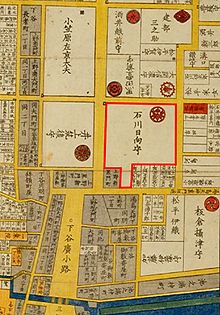Ishikawa (clan)

Ishikawa coat of arms ( Japanese autumn gentian )
The Ishikawa ( Japanese 石川氏 , Ishikawa-shi ) were a family of the Japanese sword nobility ( Buke ), which was derived from Minamoto no Yoshitoki, son of Yoshiie ( Seiwa-Genji ). With an income of 60,000 Koku , the Ishikawa residing in Kameyama ( Mie Prefecture ) belonged to the medium-sized Fudai daimyo of the Edo period .
genealogy
-
Kiyokane ( 清 兼 ) had two sons, Ienari and Yasumasa.
-
Ienari ( 家 成 ; 1534–1609), Hyūga no kami , served Tokugawa Ieyasu and accompanied him on all his campaigns against the Imagawa , Takeda , etc.
-
Yasumichi ( 康 通 ; 1554-1607), Nagato no kami , received the Naruto domain ( province of Kōzuke ) with 20,000 Koku in 1590 . After the battle of Sekigahara he was transferred to Ōgaki ( Mino ) with 50,000 koku.
- Tadafusa ( 忠 房 ; 1572–1650), a son of Ōkubo Tadachika, was adopted by Yasumichi and was his successor. Embroiled in an affair with his father Tadachika, he was deposed in 1614. Rehabilitated after the Battle of Sekigahara, he received the domain Hida ( Bungo ) with 60,000 Koku. In 1633 he was transferred to Sakura ( Shimousa ) and the following year to Zeze ( Ōmi ). - The descendants resided in Kameyama ( Ise ) from 1651 to 1669 , in Yodo ( Yamashiro ) from 1669 to 1711 , then in Matsuyama ( Bitchū ) until 1744 and finally again in Kameyama with 60,000 Koku. After 1868 Vice Count.
- A side branch was created after Tadafusa's death. The branch resided first in Kambe (Ise) and then from 1732 to 1868 in Shimodate ( Hitachi ) with 20,000 koku.
- A daughter of Yasumichi married Matsudaira Ienori of the Ōgyū-Matsudaira , whose son Matsudaira Norimasa founded a branch line that was also named Ishikawa.
-
Yasumichi ( 康 通 ; 1554-1607), Nagato no kami , received the Naruto domain ( province of Kōzuke ) with 20,000 Koku in 1590 . After the battle of Sekigahara he was transferred to Ōgaki ( Mino ) with 50,000 koku.
-
Ienari ( 家 成 ; 1534–1609), Hyūga no kami , served Tokugawa Ieyasu and accompanied him on all his campaigns against the Imagawa , Takeda , etc.
-
Yasumasa ( 康 政 ), another son of Kiyokane, Hōki no kami , received the domain of Fukashi (now Matsumoto, Shinano ) with 100,000 koku in 1590 . His grandson was involved in an affair with Ōkubo Nagayasu and was deposed in 1613.
- Kazunori ( 数 矩 ), a great grandson of Yasumasa, Higo no kami , had an income of 15,000 koku in Shinano. He too was deposed at the same time and for the same reason as his uncle Kazunori.
-
Yasumasa ( 康 政 ), another son of Kiyokane, Hōki no kami , received the domain of Fukashi (now Matsumoto, Shinano ) with 100,000 koku in 1590 . His grandson was involved in an affair with Ōkubo Nagayasu and was deposed in 1613.
Remarks
Individual evidence
- ↑ Furusawa, Tsunetoshi: Kamon daichō . Kin'ensha, undated, ISBN 4-321-31720-7 , pp. 60-
- ↑ Sugai, Yasuo: Shimodate-jo in: Miura, Masayuki (ed.): Shiro to jinya. Tokoku-hen. Gakken, 2006. ISBN 978-4-05-604378-5 .
- ↑ Excerpt from the "Shitaya" district map from around 1850.
literature
- Edmond Papinot: Historical and Geographical Dictionary of Japan. Reprint of the 1910 edition. Tuttle, 1972, ISBN 0-8048-0996-8 .
- Hashiba, Akira: Kameyama-jo in: Miura, Masayuki (Ed.): Shiro to jinya. Saikoku-hen. Gakken, 2006. ISBN 978-4-05-604379-2 .

